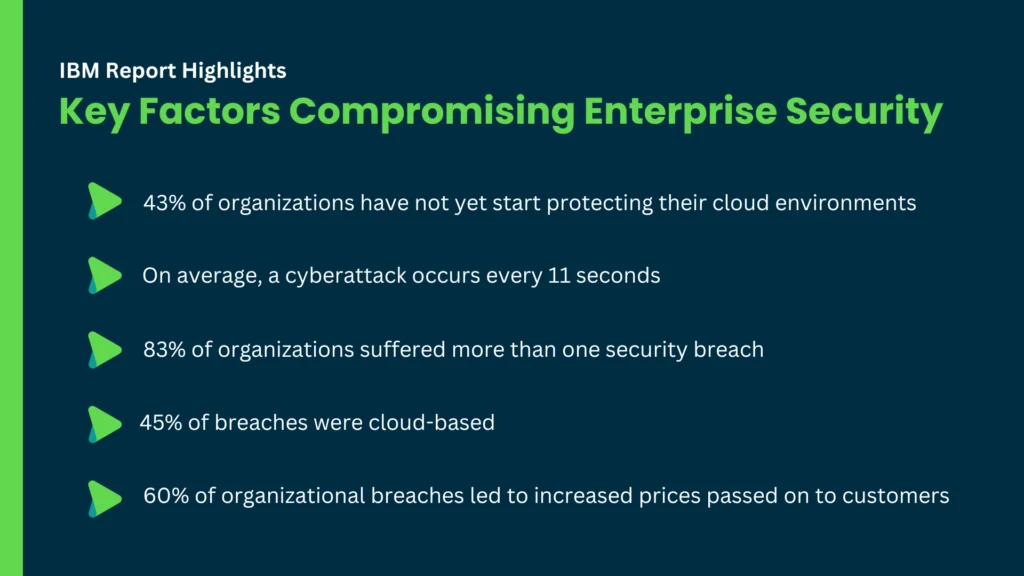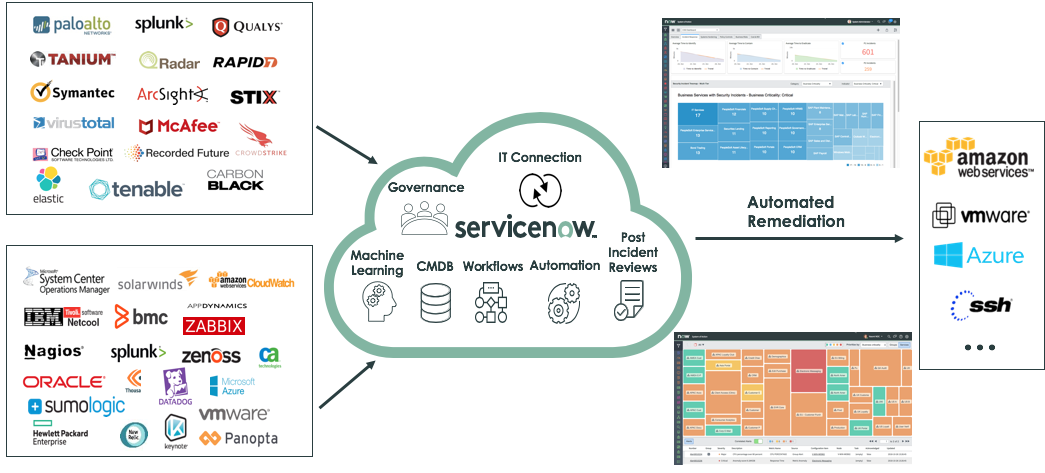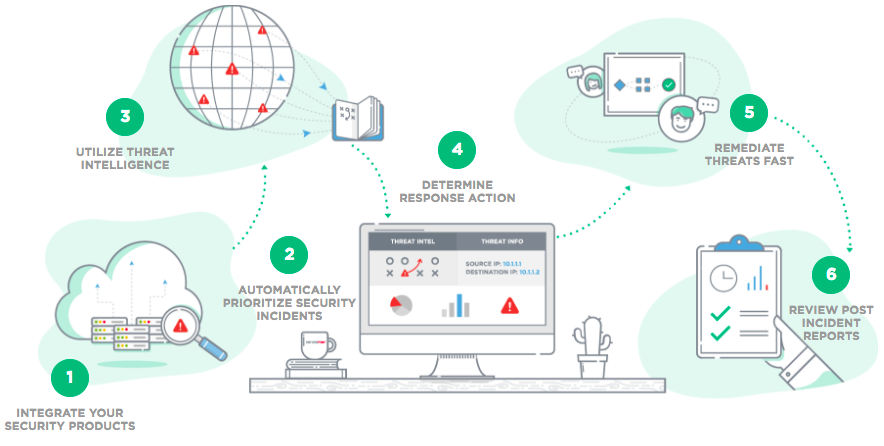The increasing volume of stolen credentials, phishing attempts, cloud misconfiguration, ransomware, cyber-attacks, data breaches, and other threats has made the path to cybersecurity fraught with challenges like siloed data, vulnerabilities, and manual processes.

That said, organizations are drowning in security debt and it is high time to address broken workflows with a fresh approach: SecOps (Security Operations).
In this article, we will explore the benefits and capabilities of ServiceNow SecOps in transforming security of enterprises. But before that, let me take you through current scenario of SecOps in enterprises.
The current state of SecOps
1. Data breach costs
The average cost of a data breach is $4.35 million. In the US, it rises to $9.44 million, and in the UK, it’s $5.05 million. These costs impact businesses through reputational loss, legal liability, and loss of business and consumer trust.
2. The role of unpatched vulnerabilities
One in five organizations does not test their software for vulnerabilities. Without knowing about vulnerabilities, fixing them proactively becomes difficult, leading to potential exploitation. Also, the use of cheap ransomware by less skilled threat actors is increasing, posing significant risks to businesses.
3. Lack of cohesion
Security teams face challenges in uniting different solutions across various security areas. There is no “one tool” for SecOps. Hence, security functions are often siloed and spread across multiple departments within an organization.
4. Complicated factors
Several factors such as lack of skilled people, outdated processes, inadequate tools, and unreliable third-party partners compound the issues and weakness of security teams.
An overview of ServiceNow SecOps
Earlier security was treated separately and was a point of concern towards the end of development. This led to a huge security gap. The concept of DevOps, DevSecOps gained immense popularity, and it became clear that security needed to be an integral part. ServiceNow SecOps originated from the need to integrate security more effectively within IT operations. SecOps use intelligent workflows, automation, and connectivity with IT teams to streamline operations.
SecOps on ServiceNow
The ServiceNow suite of security operations applications provides an efficient solution for organizational security. Here is what it offers:
1. Automatically prioritize security
ServiceNow automatically adds threat intelligence data to gather more information about potential threats. This data, along with additional malware scans, helps determine whether a threat is real or a false positive.
2. Determine response action & remediate threats fast
ServiceNow SecOps speeds up response times by automating tasks like investigations and using orchestration to integrate with other security tools, such as retrieving endpoint processes or sending firewall block requests. This boosts security team efficiency, allowing quicker and more incident responses.
3. Review Post Incident Reports
With ServiceNow Security Operations handing off tasks is simpler, and sensitive security data can be kept separate from IT. SLAs (Service Level Agreements) ensure tasks are completed in a timely fashion.

ServiceNow SecOps core features that powers cybersecurity
To counter cyber threats, there is a growing need for AI-driven, automated solutions that unify security, risk, IT, and asset management. The answer lies within ServiceNow SecOps on Now platform. Let’s dive deep into the core features of ServiceNow SecOps:
1. Security Incident Response (SIR)
Security incident response is the process of managing and addressing a security breach or cyberattack to minimize damage and recovery time. It involves detecting, containing, eradicating the threat, and learning from the incident to improve future defenses. This is what it brings:
- Security Incident Response integrates with existing security tools including firewalls, endpoint security products, third-party threat detection and security information and event management (SIEM) solutions.
- Prioritizes incidents based on business impact. This prioritization includes not only the severity of a particular issue, but also the type of asset, system or service affected which allows users prioritize security incidents.
- Enriches incidents in tandem with Threat Intelligence Automation by leveraging ServiceNow’s core workflow, automation and orchestration capabilities to create purpose-built security.
- Improves collaboration between IT, End users, and Security Teams.
- With the integrated Zero Trust and MITRE ATT&CK security framework you can stay ahead of attacks.
2. Vulnerability Response
Vulnerability Response (VR) proactively reduces the attack surface by addressing critical vulnerabilities, integrating with solutions like Qualys, Rapid 7, and Tenable to manage the response process. Key features include:
- Integration with the National Vulnerability Database (NVD) and third-party scanners
- Seamless integration with other ServiceNow functionalities
- Container Vulnerability Response addresses container vulnerability
- Application Vulnerability Response addresses identified risks.
- Policy comparison to identify configuration gaps
- Prioritization of configuration compliance issues using the CMDB
- Automatic correlation of policies and tests to configuration items
VR combines severity assessments with IT data to prioritize and respond to business-critical vulnerabilities, leveraging ServiceNow’s workflows, automation, and orchestration for rapid action.

3. Configuration Compliance
Configuration Compliance (CC) focuses on addressing misconfigured software. It uses security configuration assessment data from sources like Qualys and Tenable integrates with ServiceNow ITSM and ITOM for remediation. For instance, if an organization lacks a policy for mandatory password changes every three months, CC will flag this as a risk and suggest remediation steps. CC also feeds data to the continuous monitoring feature of ServiceNow GRC (Governance, Risk, and Compliance).
4. Threat Intelligence
ServiceNow supports STIX (Structured Threat Information Expression) and TAXII (Trusted Automated Exchange of Intelligence Information), enabling organizations to work with nearly any threat intelligence feed—whether open-source, commercial, or from sharing communities like ISAC (Information Sharing and Analysis Center). You can pull relevant threat intelligence information directly into SecOps and apply it to a security incident, providing a complete view of the issue. This enrichment increases efficiency by eliminating the need for security analysts to perform manual lookups for additional information. Threat Intelligence significantly enhances data in our SIR and VR applications by:
- Collecting intelligence from multiple external feeds.
- Automatically connecting indicators or observed compromises to a security incident.
- Seamlessly integrating with SIR and VR management.
In addition to its core features, ServiceNow Security Operations offers tools to understand asset protection, anticipate trends, prioritize resources, and improve continuously with real-time analytics. These include security posture control, performance analytics, event management, and data loss prevention incident response.
The business value of ServiceNow SecOps
Good security hygiene requires ongoing effort, but workflows, automation, and a unified platform for managing assets, vulnerabilities and risks make the process easier. ServiceNow take the burden off and frees up 8,700 hours annually. Following are some ServiceNow SecOps capabilities that can help your business thrive:
1. Strengthen your digital systems
Using outdated methods like emails and spreadsheets to manage security responses is inefficient and allows vulnerabilities to go unnoticed. Enterprises need optimized and automated workflows to break down silos and unify security, operations, and asset management. This approach reduces cyber threats and reduces the time taken to contain security breaches. A secured enterprise platform like ServiceNow SecOps empowers your systems.
ServiceNow SecOps capabilities
- Utilize AI-driven processes to reinforce your digital attack surface.
- Access crucial data on severity, business context, risk levels, exposure, and external threat intelligence.
- Use a scoring system to prioritize and drive responses.
- Leverage AI intelligence to assign mitigations and remediations efficiently to the appropriate teams.
- Achieve visibility across your entire digital infrastructure such as applications, cloud, and services to identify assets and their vulnerabilities.
- Automate patch orchestration integrated with change management systems and the CMDB to ensure continuous reinforcement of your defenses.
2. Responds with agility and minimize impact of cyberthreats
ServiceNow SecOps equips organizations with the tools to react quickly, ensuring threats are neutralized before causing significant harm.
ServiceNow SecOps capabilities
- Use real-time insights to counter evolving attack techniques, predict attacker behavior, and guide responses to significant incidents like ransomware and data breaches.
- Monitor the performance of processes and analysts for continuous improvement, reducing risk and exposure.
- Leverage integrations, playbooks, dashboards, and a common data model to accelerate investigations and responses across IT, security, and risk teams, minimizing the impact on the organization, including data loss and reputational damage.
3. Reduce cyberthreat responses
ServiceNow SecOps transforms how businesses handle cyber threats by reducing response times and streamlining processes. With a Security Orchestration, Automation, and Response (SOAR) approach, it integrates key elements like Security Operations Centers (SOC), Network Operations Centers (NOC), and Artificial Intelligence for IT Operations (AIOps) to strengthen your overall security posture.
ServiceNow SecOps capabilities
- Centralize and automate the entire security incident lifecycle, from detection to resolution, cutting down on manual efforts and speeding up response times.
- The SOAR approach scale resources and minimize errors and friction.
- Improve the efficiency and effectiveness of your SOC by automating routine tasks and using AI-driven insights for more informed decision-making.
- ServiceNow AIOps predict and prevent potential threats, reducing the number of incidents and fostering a more proactive security stance.
Move into a secure future with Aelum – leading ServiceNow Premier Partner
ServiceNow SecOps is a powerful security operations platform that empowers you to proactively identify, manage, and remediate security threats in real-time. From integrating seamlessly with existing security tools and processes, to automating workflows and providing actionable insights with AI-driven approach to ensure a swift and effective response to potential vulnerabilities.
As a ServiceNow Premier Partner, we have helped leading enterprises across the globe in implementing ServiceNow SecOps capabilities to remediate threats. We leverage the power of our 150+ certified experts to provide comprehensive security solutions, streamline incident response, and enhance overall cybersecurity posture. With our expertise, we transform security operations, enabling faster detection, efficient response, and robust protection against evolving threats. Talk to our experts today and learn how we can transform security operations.










